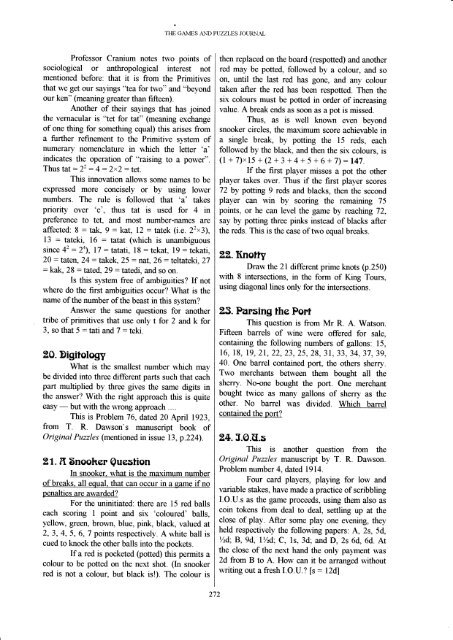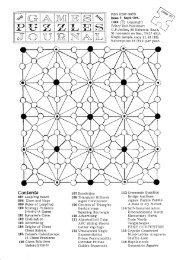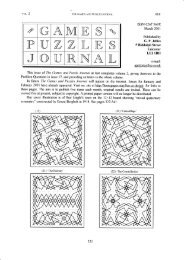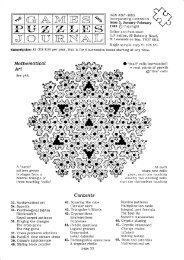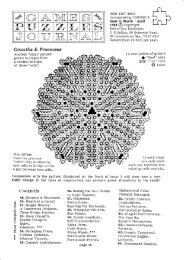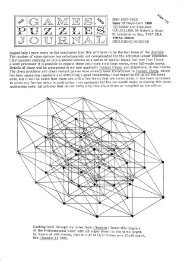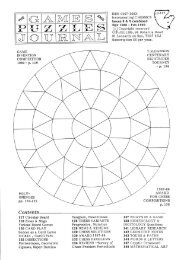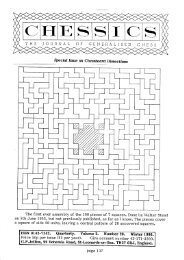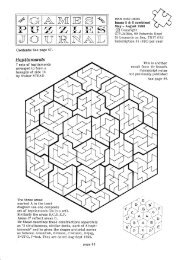The Games and Puzzles Journal, #15 - Mayhematics
The Games and Puzzles Journal, #15 - Mayhematics
The Games and Puzzles Journal, #15 - Mayhematics
You also want an ePaper? Increase the reach of your titles
YUMPU automatically turns print PDFs into web optimized ePapers that Google loves.
# GA*.{ES ANTD PLIZZLES J'LRNAL<br />
Professor Cranium notes two points of<br />
sociological or anthropological interest not<br />
mentioned before: that it is from the Primitives<br />
that rve get our sayings 'tea for two" <strong>and</strong> "beyond<br />
our ksn" (meaning greater than fifteen).<br />
Another of their sayings that has joined<br />
the vsrnacular is "tet for tat" (meaning exchange<br />
of one thing for something equal) this arises from<br />
a further refinement to the Primitive sSrstem of<br />
numerary nomenclafure in which the letter 'a'<br />
indicates the operation of "raising to a po\,\'er".<br />
Thus tat : Z? : 4 - ZxZ: tet.<br />
This innovation allows some names to be<br />
expressed moro concisely or by using lorver<br />
numbers. <strong>The</strong> rule is followed that 'a' takes<br />
priority ovsr 'e', thus tat is used for 4 in<br />
preference to tet, <strong>and</strong> most number-names are<br />
affected: I : tak, 9 : kat, 12 - tatek {i.e. ?2*3),<br />
l3<br />
since 42 : ?r), L7 : tatati, 18 : tekat, 19: tekati,<br />
20 : taten, 24 : takek. 25 : nat, 26 : teltateki, 27<br />
: kak, 28 : tated, 29 : tatedi, <strong>and</strong> so on.<br />
Is this system free of ambiguities? If not<br />
where do the first ambiguities occur? What is the<br />
name of the number of the beast in this system?<br />
Ansrver the same questions for another<br />
tribe of primitives that use only t for 2 <strong>and</strong> k for<br />
3, so that 5 - tati <strong>and</strong> 7 - teki.<br />
2rg.Digitolryy<br />
What is the smallest number which may<br />
be divided into three different parts such that each<br />
part multiplied by three gives the same digits in<br />
the answer? with the right approach this is quite<br />
easy<br />
-<br />
but with the \\nong approach ....<br />
This is Problem 76, dated 20 April lg?3,<br />
from T. R. Dalvson's manuscript book of<br />
Original <strong>Puzzles</strong> (mentioned in issue 13, p .224).<br />
ZL R Sncoher 9uesfion<br />
In snooker. what is the maximum number<br />
of breaks. all e+ual.,that can occur in a game if no<br />
penalties are ar,varded?<br />
For the uninitiated: there are 15 red balls<br />
each scoring I point <strong>and</strong> six 'coloured' balls,<br />
yellow, gresn, brown, blue, pink, black, valued at<br />
2.,3,4,,5,6,7 points rsspectively. A r,vhite ball is<br />
cued to knock the other balls into the pockets.<br />
If a red is pocketed (potted) this permits a<br />
colour to be potted on the next shot. (In snooker<br />
red is not & colour, but black is!). <strong>The</strong> colour is<br />
then replaced on the board (respotted) <strong>and</strong> another<br />
red may be potted, followed by a colour, <strong>and</strong> so<br />
on, until the last red has gone, <strong>and</strong> any colour<br />
taken after the red has been respoffed. <strong>The</strong>n the<br />
six colours must be potted in order of increasing<br />
value. A break ends as soon as a pot is missed.<br />
Thus, as is r,vell knonn svsn be5,'ond<br />
snooker circles, the maximum score achievable in<br />
a single break, by potting the 15 rsds, each<br />
followed by the black, <strong>and</strong> then the six colours, is<br />
(1 + 7)*15 + (7+3 + 4 +5 + 6 + 7l:147.<br />
If the first player misses a pot the other<br />
player takes over. Thus if the first player scores<br />
72 by potting 9 reds <strong>and</strong> blacks, then &e second<br />
player can win b,v scoring the remaining 75<br />
points., or he can level the game by reaching 72,<br />
say by potting three pinks instead of blacks after<br />
the reds. This is the case of two equal breaks.<br />
ZZ. ftrotfy<br />
Draw the 21 different prime knots {p.250)<br />
with I intersections, in the farm of King Tours,<br />
using diagonal lines only for the intersections.<br />
U3. Parsing the Port<br />
This question is from Mr R. A. Watson.<br />
Fifteen barrels of rvine were offered for sale,<br />
containing the following numbers of gallons: 15.<br />
16, 18, L9,71. 22, 23, 25,29, 3I,33, 34,37,39,<br />
40. One barrel contained port, the others sherry.<br />
Trvo merchants between them bought all the<br />
shery. No-one bought the port. One merchant<br />
bought trn'ice as many gallons of shery as the<br />
other. No barrel was divided. Which barrel<br />
contained the port?<br />
?J*. X.O.If.s<br />
This is another question from the<br />
Original <strong>Puzzles</strong> manuscript by T. R. Darvson.<br />
Problem numbet 1, dated 1914.<br />
Four card plal'ers, playing for lorv <strong>and</strong><br />
variable stakes. havs made a practice of scribbling<br />
I.O.U.s as the game proceeds, using them also as<br />
coin tokens from deal to deal, settling up at the<br />
close of play. After some pla,v one evening, they<br />
held respectively the following papers: A, 2s, 5d,<br />
Yrd; B, 9d, LYzd, C, ls, 3d; <strong>and</strong> D, 2s 6d, 6d. At<br />
the close of the next h<strong>and</strong> the only payment \n'as<br />
2d from B to A. Horv can it be affarrged without<br />
writing out a fresh I.O.U.? [s - lzdl<br />
272


